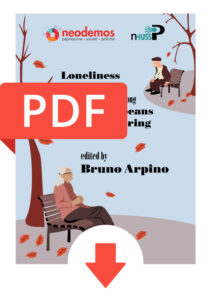Launched in 2009, the Joint Programming Initiative “More Years Better Lives” (JPI-MYBL) brought together several EU and non-EU countries to create a common research framework aiming to better coordinate, harmonize, and synchronize the research programmes of the participating countries on the topic of demographic change. In 2022, JPI-MYBL launched a knowledge-sharing process on isolation and loneliness among older people during the COVID-19 pandemic.
This resulted in a few workshops, which later led to a series of short papers and, ultimately, to the production of the e-book Loneliness and social exclusion among older Europeans before and during the COVID-19 pandemic that is now available on the N-IUSSP website. Here is an excerpt from Bruno Arpino, Giuseppe Gabrielli and Heidrun Mollenkopf’s introduction.
The demographic changes of the past and coming years will profoundly modify the population structure in Europe. These transformations are associated with changes in the distribution of resources and opportunities across Europe and beyond – changes that require adjustments in all areas of life, both at individual level and across society as a whole. Among these changes, population ageing is a long-term trend, which began several decades ago in Europe. Increased life expectancy is a triumph for humanity but, coupled with fertility reduction and postponement, it causes population ageing.
Social isolation and feelings of loneliness among older people are among the challenges posed by population ageing and shrinking family networks. Isolation and loneliness have negative consequences on individuals that may result in poor physical health, unhealthy behaviours, poor wellbeing and, ultimately, depression.
Loneliness also has an economic cost for individuals and society; it reduces interpersonal interactions, and thus social capital, and adversely affects physical and mental health. Research has estimated that the annual cost of loneliness is about 1,000 euros per capita. Individuals who feel lonely also tend to use healthcare services more than others, with negative consequences on public health expenditures.
Loneliness and social isolation among older adults were already important research and policy topics before the onset of the COVID-19 pandemic. However, the spread of COVID-19 and the social distancing measures to limit transmission of the virus exacerbated pre-pandemic vulnerabilities linked to isolation and loneliness in ageing societies.
Isolation, loneliness, and the COVID-19 pandemic
In the decades preceding the COVID-19 pandemic, scholars and public health officials became increasingly concerned about the growing risks of loneliness driven by societal shifts such as fertility decline, the increase in one-person households and other factors, especially in the United States and Europe.
After the outbreak of the pandemic, physical distancing was imposed or encouraged at national, regional, and local levels, to mitigate the spread of COVID-19. People were asked to avoid public social spaces and minimize physical contact with others. Measures also included stay-at-home orders, and full physical isolation of high-risk individuals, such as older adults with pre-existing conditions. While these mitigation measures were effective in slowing the spread of COVID-19 and reducing mortality, they may have increased isolation among older adults, possibly exacerbating the “loneliness pandemic” and the risk factors for loneliness.
Studies have suggested that older adults were more resilient to loneliness than younger adults during COVID-19. Thus, increased physical isolation due to the anti-COVID restrictions does not seem, on the whole, to have exacerbated feelings of loneliness among older adults. This finding may reflect a combination of factors, including lowered expectations for social interaction during the pandemic or increased contact at a distance.
Although possibly more resilient than younger adults, it is unclear whether, and to what extent, older adults across Europe experienced increases in loneliness during COVID-19. Existing evidence offers mixed results. In addition, although some studies showed unchanged feelings of loneliness among older adults overall, relevant heterogeneities may exist. Along this line, Arpino et al. (2022) show that individuals who lack certain close family ties (e.g., unpartnered people) have been at higher risk of reporting increased feelings of loneliness since the onset of the pandemic. This suggests that older people who lacked emotional and practical support might have been particularly exposed to its direct and indirect consequences. Van Tilburg (2022) shows that loneliness, and particularly emotional loneliness, increased between 2019 and 2020, although having a partner before the pandemic provided some protection.
Given that informal caregiving is mostly provided by close family members, childless and unpartnered individuals were, in principle, those at highest risk of experiencing unmet care needs during the pandemic. In fact, research has shown that family caregiving continued during the pandemic, in some cases replacing formal care services to avoid possible contagion by care professionals. Studies have also reported higher anxiety and depression among family caregivers during the pandemic.
The increased need of care and the heavier burden placed on family caregivers call for new policy and practice solutions. Older people in residential care are at a particularly high risk of isolation, loneliness and reduced care. COVID‑19 has pointed up an urgent need for higher standards of care in nursing homes in Europe, and for the development of community-based alternatives and services to support persons with care needs and families with care responsibilities.
These alternatives and services could be inspired by the principles outlined in a UN (2020) policy brief launched in the early phases of the pandemic. The development of good quality, affordable, available, and accessible community-based services being paramount for meaningful inclusion in the community, these services should be developed in collaboration with all stakeholders, from users to practitioners, including persons with care needs and their families. In parallel, broader-scope interventions to reduce isolation and loneliness among the general population can, and need to be, implemented, e.g. by improving public transport and through laws and policies to address ageism, inequality and the digital divide (WHO 2021).
References
Arpino B., Mair C. Quashie N., and Antczak R. (2022) Loneliness Before and During the COVID-19 Pandemic: Are Unpartnered and Childless Older Adults at Higher Risk? European Journal of Ageing. 19, 1327–1338.
United Nations (UN) (2020) The Impact of COVID-19 on older persons.
Van Tilburg, T. G. (2022). Emotional, social, and existential loneliness before and during the COVID-19 pandemic: Prevalence and risk factors among Dutch older adults. The Journals of Gerontology: Series B, 77(7), e179-e184.
World Health Organization (WHO) (2021). Social isolation and loneliness among older people: advocacy brief. WHO: Geneva.



